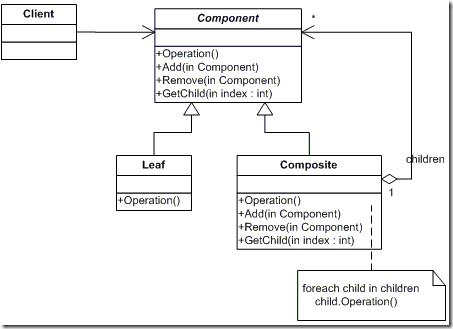- 定义
组合模式(Composite),将对象组合成树形结构以表示‘部分-整体’的层次关系(树状结构)。组合模式使得用户对单个对象和组合对象使用具有一致性。
- 意图
希望用户可以忽略单个对象和组合对象的区别,统一使用组合结构中的所有对象(封装变化的思想)。
- 结构图
图1组合模式(Composite)结构图
- 参与者
Component
它是一个抽象角色,为对象的组合提供统一的接口。
为其派生类提供默认的行为。
通过该接口来访问和管理Child Components(节点后继)。
通过该接口来访问Parent Components(节点前驱)。
Leaf
代表参加组合的叶子对象(叶子没有后继)。
定义组成原始对象的行为。
Composite
定义非叶子对象的行为。
实现Component中的孩子操作行为(如:Add(),Remove() 等)。
在使用组合模式中需要注意一点也是组合模式最关键的地方:叶子对象和组合对象实现相同的接口。这就是组合模式能够将叶子节点和对象节点进行一致处理的原因。
组合对象的关键在于它定义了一个抽象构建类,它既可表示叶子对象,也可表示容器对象,客户仅仅需要针对这个抽象构建进行编程,无须知道他是叶子对象还是容器对象,都是一致对待。
建一个抽象类:
package composite;
public abstract class Component {
protected String name;
public Component(String name) {
this.name = name;
}
public String getName() {
return name;
}
public void setName(String name) {
this.name = name;
}
public abstract void display();
}
建一个子类容器:
package composite;
import java.util.ArrayList;
import java.util.List;
public class Composite extends Component {
private List<Component> childen = new ArrayList<Component>();
public Composite(String name){
super(name);
}
public void remove(Component c) {
this.childen.remove(c);
}
public void add(Component c) {
this.childen.add(c);
}
@Override
public void display() {
for (Component c : childen){
c.display();
}
}
}
可以看到子类容器增加了两个方法,并重写了父类的display方法。
新增一个叶子节点:
package composite;
public class Leaf extends Component {
public Leaf(String name) {
super(name);
}
@Override
public void display() {
System.out.println("this leaf's name is " + super.getName());
}
}
测试下
package composite;
/**
* 组合模式
*
* @author mercy
*
*/
public class Test {
public static void main(String[] args) {
Composite c=new Composite("容器对象");
Leaf l=new Leaf("叶子节点");
c.add(l);
c.display();
}
}
结果:
this leaf's name is 叶子节点
